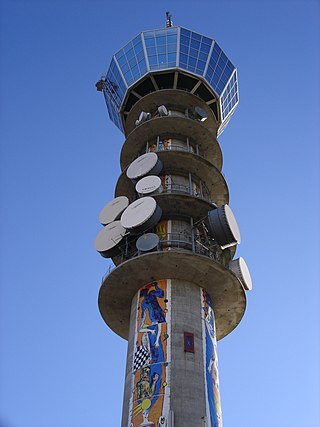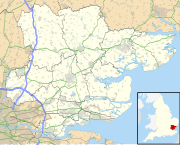
Guglielmo Giovanni Maria Marconi, 1st Marquis of Marconi was an Italian inventor, electrical engineer, physicist, and politician, known for his creation of a practical radio wave–based wireless telegraph system. This led to Marconi being credited as the inventor of radio, and winning the 1909 Nobel Prize in Physics with Karl Ferdinand Braun "in recognition of their contributions to the development of wireless telegraphy". His work laid the foundation for the development of radio, television, and all modern wireless communication systems.
The early history of radio is the history of technology that produces and uses radio instruments that use radio waves. Within the timeline of radio, many people contributed theory and inventions in what became radio. Radio development began as "wireless telegraphy". Later radio history increasingly involves matters of broadcasting.

Shortwave radio is radio transmission using radio frequencies in the shortwave bands (SW). There is no official definition of the band range, but it always includes all of the high frequency band (HF), which extends from 3 to 30 MHz ; above the medium frequency band (MF), to the bottom of the VHF band.

AM broadcasting is radio broadcasting using amplitude modulation (AM) transmissions. It was the first method developed for making audio radio transmissions, and is still used worldwide, primarily for medium wave transmissions, but also on the longwave and shortwave radio bands.

Radio broadcasting is the broadcasting of audio (sound), sometimes with related metadata, by radio waves to radio receivers belonging to a public audience. In terrestrial radio broadcasting the radio waves are broadcast by a land-based radio station, while in satellite radio the radio waves are broadcast by a satellite in Earth orbit. To receive the content the listener must have a broadcast radio receiver (radio). Stations are often affiliated with a radio network that provides content in a common radio format, either in broadcast syndication or simulcast, or both. The encoding of a radio broadcast depends on whether it uses an analog or digital signal. Analog radio broadcasts use one of two types of radio wave modulation: amplitude modulation for AM radio, or frequency modulation for FM radio. Newer, digital radio stations transmit in several different digital audio standards, such as DAB, HD radio, or DRM.

Chelmsford is a city in the City of Chelmsford district in the county of Essex, England. It is the county town of Essex and one of three cities in the county, along with Colchester and Southend-on-Sea. It is located 30 miles north-east of London at Charing Cross and 22 miles south-west of Colchester. The population of the urban area was 110,625 in the 2021 Census, while the wider district has 181,763.
The British Broadcasting Company Limited (BBC) was a short-lived British commercial broadcasting company formed on 18 October 1922 by British and American electrical companies doing business in the United Kingdom. Licensed by the British General Post Office, its original office was located on the second floor of Magnet House, the GEC buildings in London and consisted of a room and a small antechamber.
The year 1922 in science and technology involved some significant events, listed below.

It is generally recognized that the first radio transmission was made from a temporary station set up by Guglielmo Marconi in 1895 on the Isle of Wight. This followed on from pioneering work in the field by a number of people including Alessandro Volta, André-Marie Ampère, Georg Ohm, James Clerk Maxwell and Heinrich Rudolf Hertz.

BBC Essex is the BBC's local radio station serving the county of Essex and parts of Suffolk.

Writtle is a village and civil parish 1 mile (1.6 km) west of Chelmsford, Essex, England. It has a traditional village green complete with duck pond and a Norman church, and was once described as "one of the loveliest villages in England, with a ravishing variety of ancient cottages". The village is now home to Writtle University College, one of the UK's oldest and largest land-based colleges and a partner institution of the University of Essex, the grounds of which once housed a Royal hunting lodge, later the possession of the De Brus and De Bohun families.
The Marconi Company was a British telecommunications and engineering company that did business under that name from 1963 to 1987. Its roots were in the Wireless Telegraph & Signal Company founded by Italian inventor Guglielmo Marconi in 1897, which underwent several changes in name after mergers and acquisitions. The company was a pioneer of wireless long distance communication and mass media broadcasting, eventually becoming one of the UK's most successful manufacturing companies. In 1999, its defence equipment manufacturing division, Marconi Electronic Systems, merged with British Aerospace (BAe) to form BAE Systems. In 2006, financial difficulties led to the collapse of the remaining company, with the bulk of the business acquired by the Swedish telecommunications company, Ericsson.

Peter Pendleton Eckersley was a pioneer of British broadcasting, the first chief engineer of the British Broadcasting Company Limited from 1922 to 1927 and chief engineer of the British Broadcasting Corporation until 1929.

CINW was the final call sign used by an English language AM radio station in Montreal, Quebec, which, along with French-language sister station CINF, ceased operations at 7:00 p.m. ET on January 29, 2010. Owned and operated by Corus Quebec, it broadcast on 940 kHz with a full-time power of 50,000 watts as a clear channel, Class A station, using a slightly directional antenna designed to improve reception in downtown Montreal.
The timeline of radio lists within the history of radio, the technology and events that produced instruments that use radio waves and activities that people undertook. Later, the history is dominated by programming and contents, which is closer to general history.
1920 in radio details the internationally significant events in radio broadcasting for the year 1920.

PCGG was a radio station located at The Hague in the Netherlands, which began broadcasting a regular schedule of entertainment programmes on 6 November 1919. The station was established by engineer Hanso Idzerda, and is believed to have been Europe's first sustained broadcasting station, as well as one of the first stations in the world to transmit entertainment intended for a general audience.

The New Street Works was a manufacturing plant built for the Marconi Company in Chelmsford, England in 1912. It is credited as being the first purpose-built radio factory in the world.
This is a list of events from British radio in 1922.












